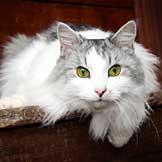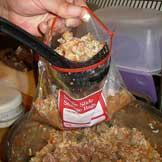
I didn’t make it to the American Academy of Veterinary Nutrition Symposium this year, but I recently reviewed some of the research that was presented there. I want to share the results of one study that looked at the differences in body composition between indoor, neutered cats, and outdoor, intact cats.
The researchers used something called dual energy X-ray absorptiometry to determine the percentage of the cats’ bodies that were composed of fatty tissue versus lean tissue. The 16 indoor, neutered cats were typical pets with owners while the 21 outdoor, intact cats came from a trap-neuter-release program. All cats were between 1 and 6 years of age.
In the practice setting, veterinarians use body condition scores (BCS) to determine whether or not an individual animal is under, over, or at their ideal body weight. A BCS of 5 out of 9 is considered ideal. Lower numbers indicate an increasingly thin body condition while higher numbers are associated with increasing levels of obesity. The cats in this study were all assessed to have body condition scores of 4 or 5 out of 9. In other words, these cats were on average a touch on the skinny side.
The research showed that outdoor, intact cats had a lower fat mass (17.3%) and higher lean mass (79.9%) than did the indoor, neutered cats (22.1%) and (74.6%) respectively. Also the average body weight of the indoor, neutered cats was 9.2 pounds but only 7.3 pounds in the outdoor, intact cats.
What’s most fascinating is that these relatively large differences were found despite the average BCS of the outdoor, intact, and indoor, neutered cats being essentially the same. This brings into question the effectiveness of BCS as a way to evaluate body condition, but since we don’t have a readily available alternative, we’re stuck with what we’ve got. Perhaps in indoor, neutered cats we should consider 4 out of 9 rather than 5 out 9 as our new “ideal.”
I suspect that the differences in body composition in these two groups of cats were caused by a combination of diet, activity level, and hormonal status. I’m not about to start recommending that clients stop spaying and neutering their cats. (Have you ever tried to live with a tom cat or queen?) Therefore, we’re left with diet and exercise as the keys to keeping cats slim and healthy … as always.

Dr. Jennifer Coates
Reference:
Body composition of outdoor, intact cats compared to indoor, neutered cats using dual energy x-ray absorptiometry. Cline MG, Witzel AL, Moyers TD, Bartges JW, Kirk CA, University of Tennessee, Department of Small Animal Clinical Sciences. Accessed on the Veterinary Information Network. New Knowledge in Nutrition: Updates from AAVN/ACVIM 2013. September 15, 2013 (published). Craig Datz, DVM, DABVP, DACVN; Allison Wara, DVM.
Image: Aksenova Natalya / Shutterstock









